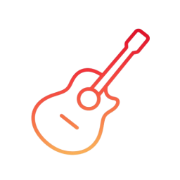 Guitar Chords Libray
Guitar Chords LibrayA chord is a group of three or more different notes played simultaneously. These notes form a harmonic structure that gives music depth and emotion. Most chords are built by stacking intervals of thirds above a root note. Chords are used to establish tonality, create progressions, and support melodies.
Chord symbols are a shorthand used in lead sheets and chord charts to represent chords. Each symbol contains a root letter and optional suffixes that define the chord type:
Seventh chords are four-note chords formed by adding a seventh interval above the root. They add harmonic complexity and are widely used in jazz, blues, and classical music. Common seventh chords include:
| Chord Type | Symbol | Formula | Example (C root) |
|---|---|---|---|
| Major 7th | Cmaj7 | 1 - 3 - 5 - 7 | C - E - G - B |
| Dominant 7th | C7 | 1 - 3 - 5 - ♭7 | C - E - G - B♭ |
| Minor 7th | Cm7 | 1 - ♭3 - 5 - ♭7 | C - E♭ - G - B♭ |
| Half-Diminished | Cm7♭5 or Cø | 1 - ♭3 - ♭5 - ♭7 | C - E♭ - G♭ - B♭ |
| Fully Diminished | C°7 | 1 - ♭3 - ♭5 - ♭♭7 | C - E♭ - G♭ - A |
Altered chords are chords that include tones outside the standard major or minor scale. They often appear in jazz and modern music to introduce tension or color. Types include:
Chord inversions occur when a note other than the root is played in the bass. This changes the chord's sound and can smooth harmonic transitions. For example:
Inversions are useful for voice leading and creating melodic bass lines.
In tonal harmony, chords serve different functions depending on their role in a key. The three main functions are:
For example, in C major: C (I) → F (IV) → G (V) → C (I) forms a complete and satisfying progression.
Source: Information gathered from verified music theory texts and online education resources. We aim for accuracy and clarity—suggestions are welcome.